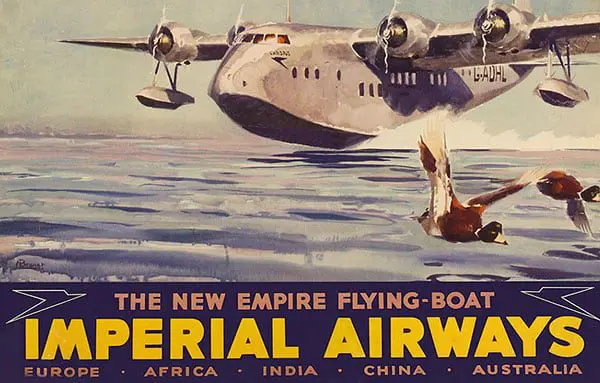Let’s travel back in time to an era when a long haul flight really was LONG. We’re talking a 12-day marathon here, and the worse bit? You might not even make it to your final destination.
Why?
Because flying simply wasn’t as safe back then as it is now. (However, it probably was way more glamorous, as these vintage airline ads and sexy flight attendant uniforms demonstrate).
The dawn of aviation followed the first World War, when Imperial Airways – the great grandaddy of British Airways – began flying around the world.

Back then, flights that now take just a few hours took literally days, and sometimes even weeks, such as the 12-day marathon I referred to above in the intro, which was actually Imperial Airways’ service from London to Brisbane.
Check out this old school route map of Imperial Airways’ network:

The London to Brisbane service, a trip that takes around 24 hours to complete these days, stopped off 11 times along its 12 days journey!
Eleven times!
Compare that to the single or two stopover flight these days, and soon to be Qantas non-stop service in 2017 between Australia and the UK.
Another lengthy trip was its London to Cape Town service, which took at least nine days – yep, that’s quite a bit longer than today’s 11-hour flight time.
The 100-year history of Imperial Airways/British Airways has been compiled in a new book by the curator of the British Airways’ Heritage Centre, Paul Jarvis, called Mapping The Airways.
In the 160-page book, Jarvis reveals the intriguing charts that guided aviators, along with adverts that showed passengers where they could jet off to.
Such as these bad boys:




Mapping The Airways also looks at the rise of modern aviation and the emergence of British European Airways which operated the world’s first scheduled jet service.
The book also looks at the development of the modern moving map featured on today’s aircraft, which remains one of the most popular in-flight entertainment programmes for travellers, fascinated by their journey around the globe.
“It’s clear that maps have long held a fascination for travellers and airlines have used maps in different artistic styles over the decades to entice the public to take to the skies.”
These vintage maps also show how far we’ve come as an industry.
These days, airlines around the world are battling it out to see who can operate the longest flight, on services that can literally fly us halfway around the world non-stop.
Truly exciting times!







